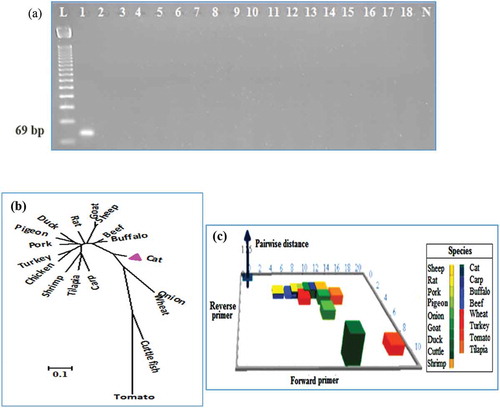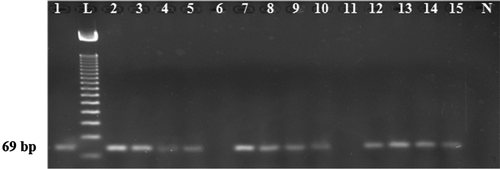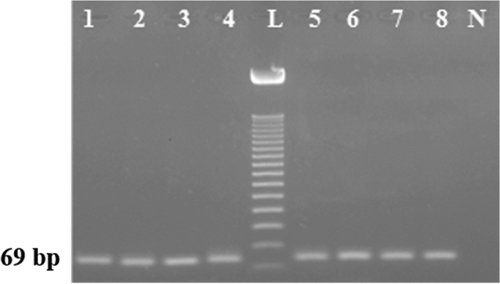Figures & data
TABLE 1 History and sources of species and samples analyzed
TABLE 2 A list of components commonly used to prepare beef, chicken, and cat meatballs (100 g) in this experiment
TABLE 3 Pairwise distances between 69 bp cytb feline-specific site and common meat, fish, and plant species potentially found in meatball formulations
FIGURE 1 Cross-amplification of feline-specific target (69 bp; Lane 1) against 17 different species (Lanes 2–18). A: In A, Lane L: 50 bp ladder, 1: cat, 2: beef, 3: buffalo, 4: chicken, 5: goat, 6: sheep, 7: pigeon, 8: pork, 9: duck, 10: rat, 11: turkey, 12: carp, 13: cuttle, 14: shrimp, 15: tilapia, 16: tomato, 17: onion, 18: wheat, and Lane N: negative control. In B, dendogram built by neighbor-joining method against primer binding region of the feline target and similar region of the cytochrome b/cob gene of the other species said in A. In C, 3D plot showing mismatch and pairwise distance of the forward and reverse primers.

FIGURE 2 Feline adulteration detection in feline, bovine, and wheat flour ternary mixtures. Lanes 1, 6, and 11: 100% raw cat meat, beef, and wheat flour, respectively. 10, 5, 0.2, and 0.01% feline meat containing admixtures before any treatments (Lanes 2–5), after extensive autoclaving (120°C for 2.5 h under 45-psi p; Lanes 7–10) and after boiling (Lanes 12–15). Lanes L: ladder and Lane N: negative control.

FIGURE 3 Stability of the feline target under autoclaving at 110°C for 2 h (Lane 1); 120°C for 50 min (Lane 2); 133°C for 20 min (Lane 3), and 120°C for 2.5 h (Lane 4); microwave heating at 300 (Lane 5), 500 (Lane 6), and 700 W (Lane 7) for 15–30 min and boiling at 100°C for 90 min (Lane 8). Lane L: ladder and lane N: negative control.

TABLE 4 Screening of commercial beef and chicken meatballs
FIGURE 4 Analysis of A: beef and B: chicken meatballs for feline adulteration. In A, Lanes 1–5: raw; 6–10: boiled; and 11–15: autoclaved beef meatballs spiked with 10, 1, 5, 0.1, and 0.01% feline meats, respectively. In B, Lanes 1–3: commercial beef and 4–6: commercial chicken meatballs. Lanes 7–11: boiled and 12–16: autoclaved chicken meatballs spiked with 10, 1, 5, 0.1, and 0.01% feline meats, respectively. Lane L: Ladder and N: negative control.

FIGURE 5 Comparative stability analysis of a shorter (69 bp; developed in this study) (Lanes 1–5 and 11–12) and longer (108 bp; previously documented; Lanes 6–10 and 13– 14 feline DNA targets after autoclaving (lanes 1–10) at 133°C for 30 (Lanes 1 and 6), 60 (Lanes 2 and 7), 90 (Lanes 3 and 8), 120 (Lanes 4 and 9), and 150 (Lanes 5 and 10) min under 43.51 psi and microwave cooking (Lanes 11–14) at 600 W (Lanes 11 and 13) and 700 W (Lanes 12 and 14) for 30 min. Please note that while the 69 bp was amplified under all treatments (Lanes 1–5 and 11–12), the 108 bp target was not detected after 150 min of autoclaving (Lane 10) and microwaving at 700 W for 30 min (Lane 14).

